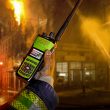Butting heads over abutting spectrum (with related video)
In both the public-safety and enterprise arenas, many of the most popular applications are driven by the location of a particular user or asset. Navigation and dispatch systems specifically are focused on location and direction, while an ever-expanding set of systems depend on accurate location recognition to determine an application's relevance, such as sending alerts to personnel in a given geographic area or a retailer pushing a virtual coupon to a potential customer who is in the vicinity of a store location.
There are multiple technological ways to determine location, but the most-used method is to leverage the satellite-based Global Positioning System (GPS) maintained by the United States government. Like all satellite technologies, GPS utility is limited when the satellite does not have a clear view of the user or asset — most notably, when a user is indoors or outdoors in a dense metropolitan area with a lot of large buildings — but it provides an effective, affordable way to determine location in most outdoor environments.
Ensuring that GPS remains useful and reliable is at the heart of a controversy centered on LightSquared, an established satellite-communications provider (operating under a variety of different names) that plans to build a nationwide, terrestrial LTE network that would operate on the company's satellite spectrum — airwaves that are adjacent to the GPS spectrum.
LightSquared's proposed LTE network is attractive to policymakers for multiple reasons. Deploying and maintaining a new nationwide network would generate lots of jobs and pump significant dollars into a U.S. economy that is struggling to create jobs and attract investment.
Moreover, Verizon and AT&T dominated the 700 MHz spectrum auction, meaning many other existing wireless carriers lack the broadband spectrum necessary to deploy 4G networks, which many analysts believe effectively will reduce competition in the market. LightSquared has agreed to pursue a wholesale model with its network, which could provide smaller and regional carriers with a path to offer customers LTE service throughout the U.S. without having to pay the enormous upfront costs associated with spectrum acquisition and network deployment.
However, the GPS industry and high-ranking officials in numerous organizations — from the military to commercial entities — have expressed concern over the past year that LightSquared's relatively strong LTE signals will interfere with the relatively weak GPS signals, which could negatively impact myriad location-based applications, many of which are inherently mission-critical.
GPS proponents believe that because their systems have been in place for years, LightSquared should be required to develop its system in a manner that does not interfere with the GPS community's large incumbent user base. In response, LightSquared officials claim that the problem is the result of the GPS industry historically using lower-quality receiver technology that does not filter out signals from LightSquared's adjacent spectrum. However, it should be noted that this strategy was not a problem until LightSquared decided to pursue a terrestrial LTE strategy.
LightSquared has proposed to initially deploy its LTE network so that it uses only the spectrum that is farthest away from GPS operations, which would eliminate the interference issue for all GPS devices except the high-precision gear used in the agriculture, surveying and construction industries, according to company officials. Meanwhile, the GPS industry has asked the FCC to ban LightSquared from ever using its spectrum near GPS operations for terrestrial operations, not just in the initial phase of its deployment.
Amid the finger pointing between LightSquared and the GPS community, the FCC and other federal policymakers are left to wrestle with numerous spectrum-policy questions:
- Did the FCC err in allowing LightSquared to pursue deployment of a terrestrial LTE network that many industry observers claim is incompatible with adjacent satellite operations?
- Should economic concerns such as jobs and investment be considered? If so, how much?
- Should LightSquared be required to undergo further testing to prove its assertion that its strategy will not interfere with the billions of commercial devices that depend on GPS?
- Has the GPS industry acted improperly by allowing its receivers to accept signals from LightSquared's spectrum? If so, is it responsible to address any interference issues?
- If a technical remedy is identified and determined to be necessary, who should pay for it — LightSquared, GPS manufacturers or taxpayers?
Most industry observers believe that federal policymakers will need to address these questions early in 2012, so that all affected parties can proceed with their plans. Regardless of the decisions made, the answers not only will impact near-term developments for LightSquared and the GPS industry, they likely will set important precedents that will have long-lasting impact on future spectrum policy.
Check our December print edition for more 2012 analysis and predictions.

















